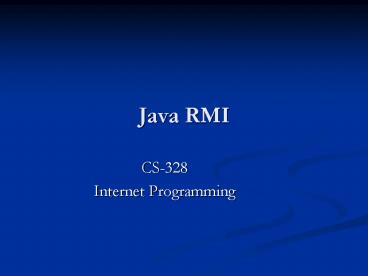Java RMI - PowerPoint PPT Presentation
Title:
Java RMI
Description:
provide user with a 'thin client ' allows good performance on lowend ... Compile the Interface (javac) Compile the Server (javac) Compile the Client (javac) ... – PowerPoint PPT presentation
Number of Views:39
Avg rating:3.0/5.0
Title: Java RMI
1
Java RMI
- CS-328
- Internet Programming
2
In the Good Old Days...
Only local objects existed
My Machine
My Object
3
Todays World...
Network and Distributed Objects
My Machine
Remote Machine
Local Objects
Remote Objects
4
Why not just use sockets?
- sockets programming is tedious
- error prone for implementing complex protocols
- best left to the experts
5
Java RMI allows...
- provide user with a thin client
- allows good performance on lowend workstations
- run server on high end hardware
- maximize investment over many clients
- server remote from client
- Distributed network object
6
What RMI is...and isnt
- Java only solution to the problem of distributed
object computing - Unlike CORBA it is not language independent
- Isnt meant to replace CORBA
- Good for java only solutions, not easy to
integrate with legacy code
7
What RMI is...and isnt (cont.)
- underlying wire protocol (object serialization)
is not an open standard the good news is that
since JDK 1.2 it will optionally use the IIOP
Protocol (RMI Over IIOP) - Since it is a Java only solution objects are at
the mercy of the java interpreter and JITs for
run time performance
8
Architecture
Client
Server
Stubs
Skeletons
Remote Reference
Remote Reference
Transport
9
The General Idea
- Instantiate an object on another machine
- Invoke methods on the remote object
10
The parts...
- Client - user interface
- Server - data source
- Stubs
- marshals argument data (serialization)
- unmarshals results data (deserialization)
- Skeletons (not reqd w/Java 2)
- unmarshals argument data
- marshals results data
11
The parts... (cont.)
- Remote Reference Layer
- provides a RemoteRef object that represents the
link to the remote service implementation object.
- encodes and decodes the on-wire protocol
- implements the remote object protocols
- Transport layer
- The Transport Layer makes the connection between
JVMs. All connections are stream-based network
connections that use TCP/IP. - handles the underlying socket handling required
for communications - sets up and maintains connections
- communications related error handling
12
The steps...
- Create the Interface to the server
- Create the Server
- Create the Client
- Compile the Interface (javac)
- Compile the Server (javac)
- Compile the Client (javac)
- Generate Stubs and Skeletons (rmic)
13
To run
- Start the RMI registry
- rmiregistry is in the JSDK bib directory
- Start the RMI Server
- Start the RMI Client
- let er rip...
14
RMI Registry
- The RMI Registry is a naming service provided
with the JDK as a teaching tool or for a small
number of Remote Objects - Uses port 1099 as its default port
- Can be considered to be a reference
implementation - runs out of steam above a 100 objects
- runs on same machine as the remote object
15
RMI Registry (more)
- Use another naming service
- J2EE uses JNDI and Directory Services to provide
a more robust naming service - Silverstream uses JNDI with its own
ServiceProvider and repository for RMI
16
Activatable Objects
- Added in Java 2 SDK
- Standard RMI objects exported as
UnicastRemoteObject must run continuously - instead by implementing java.rmi.activation.Activ
atable the object can be deactivated and
reactivated remotely when a method call is made - Must use the rmid server process to take
advantage of this capability
17
Java Remote Method Protocol (JRMP)
- Proprietary, stream-based protocol that is only
partially specified is now in two versions - JDK 1.1 version of RMI and required the use of
Skeleton classes on the server - Java 2 SDK. It has been optimized for performance
and does not require skeleton classes - some implementations, such as BEA Weblogic and
NinjaRMI dont use JRMP instead use their own
wire level protocol
18
Other JDK 1.1 and Java 2 Differences
- With the Java 2 SDK
- Service interfaces are not required to extend
from java.rmi.Remote - Service methods do not necessarily throw
RemoteException.
19
Java 2 JSDK 1.3
- RMI-IIOP
- instead of using JRMP RMI will use Internet
Inter-Orb Protocol (IIOP) - IIOP is the wire protocol used for communication
between Common Object Request Broker Architecture
(CORBA) clients and servers - CORBA is a distributed object technology from the
Object Management Group (OMG) - 800 member industry group
- vendor neutral architecture
- sets the direction for RMI/CORBA Integration
- more on CORBA later































